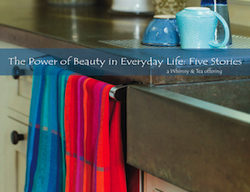In June I had the pleasure of visiting a first grade class to demonstrate and talk about weaving. They had been reading stories featuring Anansi the Spider and that led them to watching a video about weaving Kente cloth in Ghana. A friend of mine whose daughter in that class asked if I might be interested in visiting the class. I eagerly said yes.
The children had prepared some questions: How long have you been doing this? Is it hard? What are the parts of the loom and what do they do? And my favorite question: Do the patterns have any meaning (to you)?
I loved this question and understood where it was coming from. In Ghana, both the patterns of vertical stripes and the motifs they weave into their cloth have specific meanings.
The short answer is: No.
There is a longer answer.
I have thought about this question of meaning, patterns and tradition.
On a textile tour in Peru in 2007, I marveled that each Andean village we visited had unique weaving techniques and styles of dress. Their patterns reflect their life, environment and history: rivers, lakes, potato flowers, llamas, condors, and single-bladed plows to name but a few.
When I traveled back to India with my father in 2009, I spent some time in Gujarat learning about their embroidery. I was struck by how each tribal group had its unique style. Several groups might embroider peacocks and scorpions, but each will look quite different. For example, one group incorporates mirrors of different sizes and shapes while another uses only small round ones.
Learning about these weavers and embroiderers and their traditional patterns I was a little envious.
I was not raised in a community of weavers, learning patterns and their meaning by watching my mother and grandmother. My mother taught me to knit and embroider and I did needlepoint with my grandmother. Neither of them wove.
There was no expectation that I would embroider blouses, skirts, bags, quilt covers, and more for my dowry. Were I a Rabari tribeswoman, you would immediately know my martial status from my veil. But you cannot tell from my jeans whether I am single, married or widowed, although if you saw me wearing my PEI t-shirt you might assume that I had been to Prince Edward Island.
And yet I learned to weave. I have had fabulous teachers and read lots of books. I do stand in a tradition of American handweavers, a tradition with European roots that includes design names like Rosepath, Dornick Twill, Herringbone or more descriptive ones like Lily of the Valley, King’s Delight, and Mountain Cucumber.
These names do not have deep symbolic meaning for me. When I weave a towel with Dornick Twill, I do not feel like I am embedding meaning into the cloth. Now that I live in western Massachusetts, I do not weave designs that represent nuthatches, lilacs, picket fences or thunderstorms. However, I will choose color combinations that reflect this landscape.
The truth is that I like geometry and the mathematics of weaving. Figuring out variations brings me joy in a way that I don’t think symbols would. The possibilities of weaving are endless and there is so much that I will never try.
Had I been born in a different time or place, I might have grown up in a community of weavers with very clear expectations around handwork. But I am here in the States in the twenty-first century. I have chosen to weave kitchen towels on my hand- and foot-powered floor loom.
Do the patterns I weave have any meaning (to me)? They do not have meaning in a symbolic way. They do have meaning as I come to appreciate my tradition and as I do my small part to keep this tradition alive.
My invitation to you: Is there something you do in your everyday life that holds particular meaning for you because it connects you to a tradition, to your roots? I’d love to hear.





This is a terrific article Marilyn and raised all kinds of questions for me. As a ‘sometimes’ artist (whenever the mood hits me) I never thought I had a particular style since I play with all kinds of materials, subjects etc. Yet, an artist friend said, “yes you do have a style” and pointed out how she could always recognize my artwork and why. I guess my style is whatever I feel like playing with at the time!
I have to admit, your ‘tradition’ question has me contemplating if there is anything I do based on my ‘roots’–nothing comes to mind immediately…except perhaps being playful as my Mother was very playful and taught me how to bring play into my day. I always enjoy your e-zines!
A beautiful and thought provoking essay. I too weave without a real tradition, in fact, living in Australia, there is even less of a tradition than in the USA, as Australia was settled well after the industrial revolution began. I weave for the love of it, the sheer magic of it. I consider myself extremely lucky and fortunate that I even discovered it at all. The patterns to be found in Marguerite Porter Davison’s Handweaver’s Pattern Book have very romantic names: Cynthia’s Heirloom; Betsy Dewry’s M’s and O’s. I shall consider these patterns more carefully in future and pause to reflect on the women and men who have had tried and true weaving drafts named after them.
A lovely, intriguing topic. Thank you for raising it.
I’m always questioning and looking past the obvious for what true and when I do I feel like I’m honoring my Jewish heritage of questioning and discussing laws and traditions. Although this isn’t the visual pattern you’re referring to Marilyn, it is a pattern or frame for seeing the world which I use regularly and helps me feel connected to my heritage.
Thanks as always for sharing the inspiration you find in your work and for inspiring me!
Judy